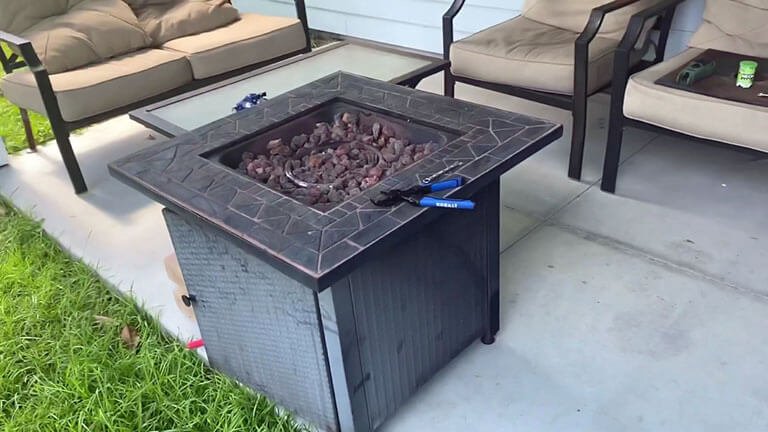Propane Fire Pit Problems: Quick Fixes & Solutions
Common propane fire pit problems include issues with ignition and uneven flames. Regular maintenance can help prevent these issues.
Propane fire pits provide warmth and ambiance for outdoor gatherings. They are popular for their convenience and ease of use. However, users may encounter various problems that can hinder their experience. Ignition failures, uneven flames, and gas leaks are some of the most frequent issues.
Understanding these problems is essential for maintaining a safe and enjoyable fire pit. Regular checks on connections, hoses, and the propane tank can help identify potential issues before they escalate. By addressing these common concerns, you can ensure that your propane fire pit remains a reliable source of heat and enjoyment for years to come.
Common Issues With Propane Fire Pits

Propane fire pits are popular for outdoor gatherings. They provide warmth and ambiance. However, users may face some common issues. Understanding these problems can help you enjoy your fire pit more.
Ignition Troubles
One of the most frustrating problems is ignition failure. This can happen for several reasons:
- Dirty Igniter: Debris can block the igniter.
- Low Propane Levels: Check the propane tank regularly.
- Faulty Connections: Loose connections may prevent ignition.
To fix ignition troubles:
- Clean the igniter with a soft cloth.
- Ensure the propane tank is full.
- Inspect and tighten all connections.
Low Flame Or Heat Production
Low flame or heat production can ruin your experience. Several factors may cause this issue:
| Cause | Solution |
|---|---|
| Clogged Burner: Debris can block gas flow. | Clean the burner with a brush. |
| Incorrect Pressure: Low pressure affects flame height. | Check the regulator settings. |
| Faulty Hose: Cracks can cause gas leaks. | Replace the hose if damaged. |
Regular maintenance can prevent these issues. Always check your fire pit before use.
Diagnosing Propane Flow Problems
Diagnosing propane flow problems in your fire pit is crucial. Issues can lead to poor performance or safety risks. Understanding common causes helps in effective troubleshooting.
Regulator Glitches
The propane regulator controls gas flow to the fire pit. A faulty regulator can cause uneven flames or low pressure.
- Check for visible damage.
- Listen for hissing sounds.
- Inspect connections for leaks.
Testing the regulator involves:
- Shutting off the propane tank.
- Disconnecting the regulator.
- Reconnecting it after a few minutes.
If the problem persists, consider replacing the regulator. A new regulator can restore optimal gas flow.
Propane Tank Complications
The propane tank is the heart of your fire pit. Issues with the tank can disrupt the entire system.
| Problem | Solution |
|---|---|
| Empty Tank | Refill or replace the tank. |
| Faulty Valve | Inspect and replace if necessary. |
| Incorrect Connection | Ensure all connections are tight. |
Always check the tank gauge. It helps you monitor propane levels. Regular maintenance prevents future complications.
Dealing With Blockages
Blockages in a propane fire pit can cause safety issues. They may lead to poor performance or even dangerous situations. Regular maintenance helps prevent these problems. Understanding how to deal with blockages is key.
Cleaning Burner Ports
Dirty burner ports can hinder flame flow. Here’s how to clean them:
- Turn off the propane and disconnect the tank.
- Remove the burner from the fire pit.
- Use a soft brush to clean the ports.
- Check for rust or debris. Remove any you find.
- Rinse with warm water and dry thoroughly.
- Reassemble the burner and reconnect the propane tank.
Regular cleaning keeps your fire pit working well. It also ensures a safe environment.
Removing Obstructions From Gas Lines
Gas line obstructions can disrupt the flow of propane. Follow these steps to remove them:
- Turn off the gas supply completely.
- Inspect the gas line for bends or kinks.
- Disconnect the line from the fire pit.
- Use a flexible brush to clear the interior.
- Inspect the line for any visible blockages.
- Reconnect the gas line securely.
- Test for leaks before use.
Regular checks prevent dangerous gas build-up. Keeping gas lines clear ensures optimal performance.
Addressing Soot And Carbon Buildup
Soot and carbon buildup can be a common issue for propane fire pits. These deposits can affect the performance and safety of your fire pit. Regular maintenance helps keep your fire pit clean and functional.
Routine Cleaning Techniques
Cleaning your propane fire pit regularly is essential. Here are some effective techniques:
- Brush the Burner: Use a soft brush to remove soot.
- Clean the Bowl: Empty the fire pit and scrub the bowl.
- Check the Hoses: Inspect hoses for any blockages.
- Use a Vacuum: A shop vacuum can remove dirt and debris.
Follow these steps to maintain your fire pit:
- Turn off the propane supply.
- Allow the fire pit to cool completely.
- Remove any loose debris.
- Apply a mild detergent with water.
- Rinse thoroughly and dry.
Preventive Measures
Preventing soot and carbon buildup is easier than cleaning it. Here are some tips to help:
- Use Quality Fuel: Always use high-quality propane.
- Avoid Burning Debris: Never burn leaves or trash in the fire pit.
- Adjust the Airflow: Proper airflow reduces soot production.
- Cover Your Fire Pit: Use a cover to keep debris out.
Keep track of maintenance with this table:
| Task | Frequency |
|---|---|
| Brush the Burner | Monthly |
| Clean the Bowl | Every 3 Months |
| Inspect Hoses | Every Season |
Regular care will enhance the longevity and safety of your propane fire pit.
Troubleshooting Thermocouple Failures
Thermocouples are vital for the safe operation of propane fire pits. They help control the flame. If your fire pit won’t light or stay lit, the thermocouple may have failed. Troubleshooting this issue can save time and money.
Testing The Thermocouple
Start by checking if the thermocouple is working properly. Here’s how:
- Turn off the propane supply.
- Remove the thermocouple from the fire pit.
- Use a multimeter to test the voltage.
Follow these steps for a successful test:
- Set the multimeter to the millivolt setting.
- Heat the thermocouple tip with a lighter.
- Check the reading on the multimeter.
A reading of 25 millivolts or more indicates a working thermocouple. Lower readings suggest a problem.
Replacement Process
Replacing a faulty thermocouple is straightforward. Here’s a step-by-step guide:
- Purchase a compatible thermocouple for your fire pit.
- Turn off the propane supply completely.
- Remove the old thermocouple.
- Install the new thermocouple by following these steps:
| Step | Action |
|---|---|
| 1 | Attach the new thermocouple to the control valve. |
| 2 | Secure it in place with screws. |
| 3 | Reattach any other components removed. |
| 4 | Turn the propane supply back on. |
After installation, test the fire pit. Light it and check for a steady flame. This indicates the thermocouple is working correctly.
Weather-related Pitfalls
Weather can greatly affect your propane fire pit. Rain, snow, and strong winds can cause various problems. Understanding these issues helps you maintain your fire pit.
Moisture And Corrosion
Moisture is a common issue for propane fire pits. It can lead to corrosion. This damage reduces the lifespan of your pit.
Here are some effects of moisture:
- Rust on metal parts
- Clogged burners
- Shortened lifespan
To prevent moisture damage, consider these tips:
- Use a protective cover when not in use.
- Store the fire pit in a dry area.
- Regularly check for signs of rust.
Taking these steps can help maintain the quality of your fire pit.
Wind Interference And Solutions
Strong winds can affect the flame of your propane fire pit. Wind can blow out the flame quickly. It can also cause uneven heating.
Consider these solutions to manage wind interference:
- Position your fire pit in a sheltered area.
- Use wind guards to shield the flame.
- Avoid using the fire pit on windy days.
Remember, safety is key. Always monitor the flame. Enjoy your fire pit safely, even in windy conditions.
Noise And Odor Issues
Propane fire pits provide warmth and ambiance. However, they can cause noise and odor problems. These issues can affect your enjoyment and comfort. Identifying the sources of these problems is essential for a pleasant experience.
Identifying The Causes
Several factors contribute to noise and odor issues in propane fire pits:
- Burner Design: Poor burner design can create loud noises.
- Gas Flow: Irregular gas flow may lead to hissing sounds.
- Fuel Quality: Low-quality propane produces unpleasant odors.
- Wind Conditions: Wind can amplify noise and distribute odors.
Identifying these causes can help you address the issues effectively.
Mitigating Unpleasant Experiences
You can take several steps to reduce noise and odor problems:
- Choose Quality Equipment: Invest in a high-quality propane fire pit.
- Regular Maintenance: Clean burners and check for blockages regularly.
- Use High-Quality Propane: Purchase propane from reputable sources.
- Wind Barriers: Install wind barriers to reduce noise and odor spread.
By implementing these strategies, you can enhance your fire pit experience. Enjoy your outdoor space without discomfort.
Safety Precautions During Repair
Repairing a propane fire pit requires careful attention to safety. Proper precautions protect you and your surroundings. Always follow guidelines to ensure a safe repair process.
Gas Leak Checks
Gas leaks pose significant dangers. Detecting leaks early can prevent accidents. Here are steps to perform gas leak checks:
- Turn off the gas supply.
- Mix soap with water in a spray bottle.
- Spray the mixture on connections and hoses.
- Look for bubbles forming.
- Any bubbles indicate a leak.
If you find a leak, take action immediately:
- Turn off the gas supply.
- Contact a professional for repairs.
Fire Pit Re-ignition Protocol
Re-igniting your fire pit needs careful steps. Follow these protocols to ensure safety:
- Wait 5-10 minutes after repairs.
- Check for gas leaks again.
- Open the lid of the fire pit.
- Turn on the gas supply slowly.
- Use a long lighter to ignite the flame.
Never attempt to light the fire pit without proper checks.
Remember these safety protocols. They protect you and your home. Stay safe while enjoying your propane fire pit!
Professional Help Vs. Diy
Dealing with propane fire pit issues can be challenging. Knowing when to seek help is crucial. Some problems are simple, while others require a professional. Understanding the difference can save time and money.
When To Call A Technician
Some signs indicate it’s time to call a technician:
- Gas leaks: Smelling gas is serious. Evacuate and call for help.
- Flame issues: If flames are inconsistent or too low.
- Unresponsive controls: If knobs or switches do not work.
- Frequent ignition failures: If the fire pit won’t light easily.
These issues often need expert knowledge. A technician can ensure safety and proper repairs.
Resources For Diy Troubleshooting
Many problems can be solved at home. Here are resources to help:
| Problem | Solution |
|---|---|
| Clogged burner | Clean with a soft brush or compressed air. |
| Dirty ignition electrode | Gently clean with a cloth. |
| Disconnected propane tank | Check connections and ensure they are tight. |
Follow these tips for effective troubleshooting:
- Always turn off the gas before starting.
- Check the user manual for specific guidance.
- Use safety gear like gloves and goggles.
- Document any changes you make for future reference.
Utilizing online forums can also provide helpful insights. Many users share their experiences and solutions.
Maintaining Your Propane Fire Pit
Keeping your propane fire pit in great shape is essential. Regular maintenance helps ensure safety and longevity. Follow these guidelines to keep your fire pit ready for use.
Regular Maintenance Schedule
Establish a maintenance schedule for your propane fire pit. Regular checks can prevent issues. Follow these steps:
- Inspect the fire pit every month.
- Clean the burners and air holes.
- Check for gas leaks with soapy water.
- Examine the hoses for wear and tear.
Keep a log of your maintenance activities. This helps track any changes or problems. Schedule professional inspections annually.
Long-term Care Tips
Proper long-term care can extend the life of your fire pit. Use these tips:
| Care Tip | Description |
|---|---|
| Cover your fire pit | Use a weather-resistant cover when not in use. |
| Store in a dry area | Keep it indoors during harsh weather. |
| Check the propane tank | Replace or refill the tank before it runs out. |
| Keep the area clear | Avoid flammable materials near the fire pit. |
These tips help maintain performance and safety. Regular care prevents costly repairs. Enjoy your fire pit for many seasons to come.
Frequently Asked Questions
What Are Common Propane Fire Pit Issues?
Common issues include ignition problems, uneven flames, and propane leaks, affecting performance and safety.
How To Fix A Propane Fire Pit That Won’t Light?
Check the igniter, ensure the propane tank is full, and inspect for blockages in the burner.
Why Does My Propane Fire Pit Smell?
A smell often indicates a gas leak. Check connections and hoses for leaks immediately.
Can Propane Fire Pits Be Used In The Rain?
Yes, but avoid using them in heavy rain to prevent water damage and safety hazards.
How To Maintain A Propane Fire Pit?
Regularly clean the burner, check for leaks, and store it properly during off-seasons for longevity.
Conclusion
Propane fire pits offer warmth and ambiance, but they can encounter various issues. Regular maintenance is key to preventing problems. Always check for leaks and ensure proper ventilation. By addressing these challenges, you can enjoy your fire pit safely and effectively.
Keep your outdoor space inviting and hassle-free year-round.






